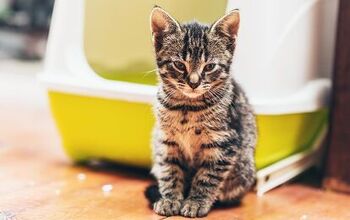Is An Automatic Litter Box Safe for My Cat?

Scooping the litter box is arguably the most disliked chore that comes from sharing your home with a cat. It’s time-consuming and messy. It can even lead to back pain for some cat parents. For some, it makes the dream of being a cat parent inaccessible due to their own physical limitations. Thankfully, the rise of technology has led to a promising new solution – the automatic litter box. But with this convenience comes a natural concern: are these automatic boxes truly safe for our feline friends?
Anytime we introduce technology to take over any aspect of our pets’ care, it should raise concerns. After all, we all want the best for our cats!
And with the rise of cheaper, often poorly manufactured knock-off products, stories of safety concerns are becoming more common on social media.
In this article, I’ll discuss the most important considerations when debating whether to introduce an automatic litter box into your home. This includes comparing the different types of boxes available and highlighting the critical safety features used by reputable brands. In the end, I hope you feel confident making an informed decision for your cat.
Automatic Litter Box Options
There are a variety of automatic litter box styles to choose from, each with its own set of pros and cons. Despite the seemingly endless list of options, they can be sorted into three general categories:
Sifting Boxes
These boxes use a sifting mechanism to remove any waste clumps from the clean litter. Sifting boxes are generally the most affordable of the automatic litter box options. They need less frequent maintenance to continue working optimally, but the sifting process isn’t always as reliable as the other options, occasionally leaving smaller clumps behind.
Example: Omega Paw NRA15 Self-Cleaning Litter Box
Self-Cleaning Boxes
Using a rake or paddle, self-cleaning boxes rake through the litter to remove waste from the clean litter and into a designated drawer. These boxes are known for being quite effective, even incorporating special features to reduce odors. However, they are more expensive than sifting boxes and require more maintenance. Some self-cleaning boxes also require specialized litter to operate effectively.
Example: PetSafe ScoopFree Crystal Pro Self-Cleaning Litter Box
Full-Cycle Boxes
The most advanced of the options (and also the highest price tag), full-cycle litter boxes completely remove all waste from the litter box, holding it in a sealed drawer or compartment. With advanced features like self-cleaning cycles and odor filters, they are the most convenient option, keeping your house clean and smelling fresh. But with all the bells and whistles, they are more complex to operate and maintain.
Example: Litter Robot 4 by Whisker
By understanding the different features, price points, and maintenance needs of each type, you can choose the automatic litter box that best suits your cat’s needs and your lifestyle.
The Rise of Knock-Off Products
Recently, there has been a growing concern about the safety of automatic cat litter boxes, sparked by the devastating stories of cat parents whose best friends were injured or even killed from their use. But before you give up on the idea of automatic boxes entirely, there are some important points to be made.
Philip Bloom ( One Man Five Cats on YouTube), an online creator and well-known product reviewer, made it his mission to uncover why this was happening and whether steps could be taken to make these boxes safe. He found that it wasn’t the concept of the box itself. Instead, it was the overwhelming number of cheaper, often poorly manufactured, knock-off products.
While the allure of the budget-friendly price point is tempting, these imitation products frequently compromise safety and quality. They create risks already addressed with higher-quality products by not incorporating the necessary safety measures.
Some of the more common safety hazards associated with these knock-off boxes include:
- Malfunctioning Mechanisms: Knock-off boxes are often poorly designed or manufactured with faulty or defective moving parts. This can lead to pinching, trapping, or injuring your cat. In the most heart-breaking cases, this can be fatal.
- Electrical Hazards: Faulty wiring and poorly applied or inadequate electrical insulation can increase the risk of short circuits, fires, or even electrocution.
- Toxic Materials: Like many other cheaply made products, some of these knock-off litter boxes are made using substandard or even harmful plastics that could release toxic fumes when heated or exposed to cat urine (which, being a litter box, they will inevitably be).
- Lack of Safety Features: Reputable brands prioritize the safety of our cats, incorporating features like motion sensors, emergency stop buttons, and reliable safety timers. Knock-off boxes are often missing most or all of these safeguards, increasing the risk of accidents
One way you can keep your cat safe while upgrading to the convenience of a new litter box is by purchasing from reputable brands with a strong track record of safety and customer service. These boxes may be a little pricier, but it is a good example of “you get what you pay for.” Reputable brands invest in rigorous testing and quality control to ensure their products meet high safety standards.
Safety Features to Look For
When shopping for an automatic litter box, you want to find one that incorporates key safety considerations to minimize the risk of accidents and keep your cat safe. Here are a few features to look for:
Motion Sensors
High-quality automatic litter boxes are equipped with monition sensors that detect the presence of a cat within the box. These sensors are crucial as they prevent the cleaning cycle from starting when a cat is inside or stop the cycle if they enter the box while it’s running. This not only prevents injuries from your cat getting caught up in the mechanisms but also helps to avoid startling your cat, which could turn them off using the box.
Safety Timers
One key factor in ensuring the box works effectively is the precise timing of the cleaning cycle after the box has been used. If it starts too quickly after, it could startle your cat when they are still nearby. It can also reduce the effectiveness of the cleaning process because it doesn’t give the litter time to clump. However, waiting too long can leave your cat with a dirty box, discouraging them from using it. This timing can usually be adjusted on the box or the phone app.
Emergency Stop Buttons
In most cases, your cat will go about their business in the box and then leave it to go about their day. However, there are always extenuating circumstances and unexpected situations that can arise, and your new litter box should have an emergency stop to manually override the cleaning cycle. This could be important if your cat shows signs of distress when using the box or if the previous safety measures fail to work as designed, allowing the box to start a cycle with your cat still inside.
Rounded Corners and Smooth Surfaces
Take a moment to examine the design and construction of the litter boxes you are considering. You want to ensure that all corners are rounded and all surfaces are smooth to minimize the risk of injury from your cat brushing against or bumping into any aspect of the box.
Tips for Choosing the Right Automatic Litter Box for Your Cat
Even after narrowing your list to just the most reputable brands, there are still many options to choose from. The truth is that there is no one-size-fits-all solution. You must carefully consider your cat’s individual needs and preferences and your own needs from a litter box to identify the best option.
Your Cat’s Anxiety Levels
Some cats will confidently use any box without hesitation, but for others, the noise and movement of the cleaning cycle of a full-cycle box could be startling or unsettling, causing stress and anxiety. Not only is this unpleasant for your cat, but it can lead to a negative association with their box and bathroom accidents around your home. If your cat is generally nervous or unsure of new noises, you may want to consider a box with quieter operation and more gradual cleaning cycles.
Size and Breed
Many automatic litter boxes feature an enclosed design. Your cat needs a large enough litter box to comfortably move around, dig, and do their business without feeling cramped. If you have a larger cat, like a Maine Coon, you may need to search for a larger-than-normal box.
Litter Preferences
Does your cat have a preferred type of litter? If so, you want to ensure you choose a litter box that is compatible with it. Some boxes are designed to be used with certain types of clumping or specialty litter (like crystal litter). They may also have limitations on litter depth, which could impact the type of litter that will work.
Space Requirements
Take a moment to consider where you plan to set up your cat’s litter box. Are there space constraints that you need to consider? Not only does this mean the floor space, or footprint, of the box but also the height. Some brands, like the Litter Robot 4, are quite tall, which could cause problems with the location you have available.
Budget
A major deciding factor when choosing your cat’s next litter box is your available budget. While having all the bells and whistles offered by a full-cycle box is nice, the price for these boxes may not be feasible. Meanwhile, some great sifting litter box options cost only $50 (or less).
Electrical vs. Manual
Most automatic litter boxes are going to require an electrical connection to operate. If your available space doesn’t include an electrical outlet, this could present a problem. If you know that you won’t have an easily accessible electrical connection, you may want to choose a litter box that operates manually. Some options can be cleaned by rotating the box, pulling out a tray, or turning a lever.
Appearance and Design
If your cat’s box will be openly visible in your home, you may want to choose a box that complements your décor. This shouldn’t be your first concern, but if you’ve already narrowed the list of options using the other factors on this list and still have a short list to choose from, why not opt for something aesthetically pleasing?
Final Thoughts: Automatic Litter Boxes and Your Cat’s Safety
The convenience of an automatic litter box is undeniable. They offer an easy solution to a messy, unpleasant chore, saving you time and energy. However, the recent online buzz about safety concerns has rightly raised questions and concerns about their suitability for our beloved cats.
By carefully considering your cat’s (and your) needs, researching available options, and selecting a box that offers the key safety mechanisms, you can make an informed decision about the best litter box for your home.
Remember that not all automatic litter boxes are created equal. By prioritizing safety and choosing wisely, you can prioritize your cat’s safety and well-being while enjoying the convenience these boxes offer. After all, who doesn’t love the idea of no longer scooping a dirty box?
Join the PetGuide community. Get the latest pet news and product recommendations by subscribing to our newsletter here.

Britt Kascjak is a proud pet mom, sharing her heart (and her home) with her “pack” which includes her husband John, their 2 dogs – Lucifer and Willow – and their 3 cats – Pippen, Jinx, and Theia. She has been active in the animal rescue community for over 15 years, volunteering, fostering and advocating for organizations across Canada and the US. In her free time, she enjoys traveling around the country camping, hiking, and canoeing with her pets.
More by Britt
























